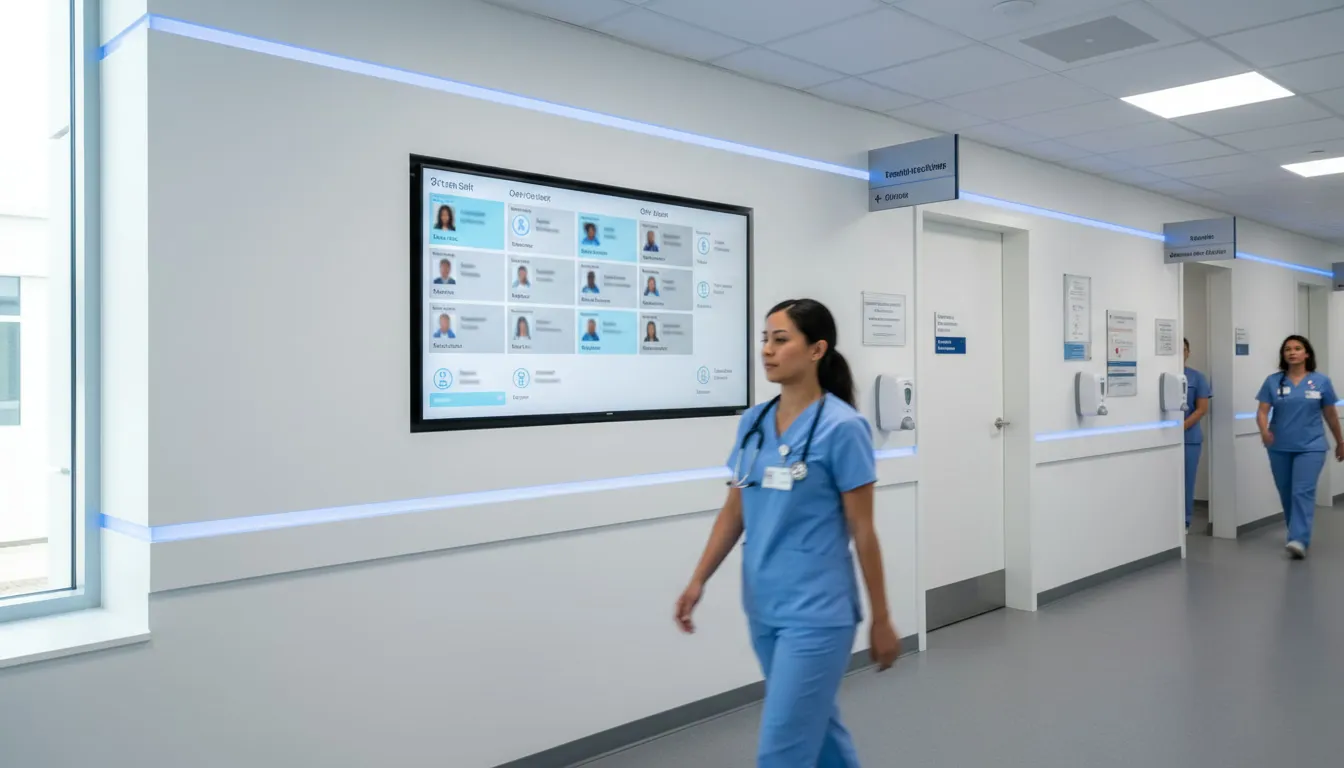· ShiftFlow Editorial Team · Glossary · 9 min read
What Is an Employee Directory? Definition, Examples & Guide
Learn what an employee directory is, key features (contact info, org charts, role details), privacy considerations (PII protection, access controls), GDPR and data protection compliance, integration with HRIS systems, and best practices for maintaining accurate internal directories.

What Is an Employee Directory?
An employee directory is a centralized database of employee contact information, organizational structure, and role details that enables internal communication and collaboration. Modern directories are searchable digital platforms containing profiles with names, job titles, departments, contact information, reporting structures, and often photos—integrated with HRIS systems for automatic updates.
Unlike public-facing staff pages, employee directories are internal resources designed to help team members find colleagues, understand organizational structure, identify subject matter experts, and facilitate communication across departments.
Quick Answer
An employee directory is an internal database of employee contact information, org charts, and role details. Essential features include searchability, contact details, department structure, and privacy controls to protect sensitive information.
According to Society for Human Resource Management research, employees spend an average of 2.5 hours per week searching for information or people within their organization. Effective employee directories reduce this search time by 40–60%, improving productivity and collaboration.
What Information Should an Employee Directory Include?
Essential Information
Required fields for functional directories:
- Full name: Legal name and preferred name if different
- Job title: Current position and level
- Department: Primary organizational unit
- Work email: Company email address
- Work phone: Direct line or extension
- Office location: Building, floor, or remote status
- Manager: Direct supervisor name and link to profile
Optional Information
Additional fields that enhance usability:
- Employee photo: Professional headshot for recognition
- Pronouns: Preferred pronouns for inclusive communication
- Start date: Tenure information
- Skills and expertise: Areas of knowledge for finding subject matter experts
- Certifications: Professional credentials relevant to work
- Direct reports: Team members for understanding structure
- Bio: Brief professional background
Information to Exclude
Never include without explicit consent and security measures:
- Social Security numbers or national identification numbers
- Home addresses or personal mailing addresses
- Personal phone numbers or mobile numbers
- Salary or compensation information
- Performance review data
- Health information or medical details
- Emergency contact information (store separately with restricted access)
Organizations managing shift workers should integrate directory access with their scheduling software to help team members identify who’s working specific shifts.
What Are the Key Features of Effective Employee Directories?

| Feature | Purpose | Implementation Priority |
|---|---|---|
| Search functionality | Find employees by name, department, or skills | Essential |
| Org chart integration | Visualize reporting structure and hierarchy | High |
| Mobile accessibility | Access directory from smartphones and tablets | High |
| HRIS integration | Automatic updates when employee data changes | High |
| Access controls | Limit visibility based on role and department | Essential |
| Profile photos | Visual recognition of colleagues | Medium |
| Advanced filters | Filter by location, department, or skills | Medium |
| Export capabilities | Download contact lists for specific use cases | Low |
| Self-service updates | Allow employees to update certain profile fields | Medium |
| Audit logging | Track who accesses directory and when | High (compliance) |
Search Functionality
Effective search includes:
- Name search: First name, last name, or full name
- Department search: Find all members of specific teams
- Role search: Locate all employees with certain job titles
- Skills search: Identify subject matter experts
- Location search: Find employees in specific offices or regions
- Partial matching: Return results even with incomplete queries
Example: Searching “market analyst Chicago” should return all marketing analysts based in Chicago offices.
Organizational Chart Integration
Visual org charts help employees understand:
- Reporting relationships: Who reports to whom
- Team structure: How departments are organized
- Span of control: How many direct reports each manager has
- Career paths: Potential advancement opportunities
Interactive org charts should be clickable, allowing users to navigate from profile to profile by clicking on names or positions.
What Are the Privacy Concerns with Employee Directories?

Data Protection Risks
Common privacy risks:
- Unauthorized external access: Directory data accessible outside the organization
- Social engineering attacks: Bad actors using directory info to impersonate employees
- Identity theft: Combination of directory data with other sources enabling fraud
- Stalking or harassment: Personal contact information enabling unwanted contact
- Competitive intelligence: Competitors mining organizational structure
- GDPR violations: Processing personal data without proper legal basis
GDPR and Data Privacy Compliance
European General Data Protection Regulation requirements:
- Legal basis: Legitimate interest (internal communication) or consent for publishing
- Data minimization: Include only necessary information
- Purpose limitation: Use directory data only for intended internal communication purposes
- Right to erasure: Remove employee data promptly after termination
- Data portability: Allow employees to export their profile data
- Privacy notices: Inform employees how directory data is used and protected
California Consumer Privacy Act (CCPA) applies more limited protections to employee data but still requires transparency about data collection and use.
Access Control Best Practices
Implement tiered access:
| Access Level | Who Has Access | What They See |
|---|---|---|
| Full access | HR, IT, executives | All fields including sensitive administrative data |
| Standard | All employees | Basic contact info, org chart, professional details |
| Restricted | Contractors, temps | Limited contact info, no org chart access |
| Public | External partners (if needed) | Only specific shared contacts with explicit approval |
Authentication requirements:
- Require company credentials for all directory access
- Implement single sign-on (SSO) through corporate identity provider
- Enable multi-factor authentication for sensitive directories
- Restrict access to corporate network or VPN when possible
- Log all directory access for security auditing
Organizations with direct hire employees and temporary employment workers should segment directory access appropriately.
How Do Employee Directories Integrate with HRIS Systems?

Integration Benefits
Automatic synchronization prevents directory drift:
- New hire onboarding: Profiles created automatically when employees are added to HRIS
- Role changes: Promotions and transfers update instantly
- Department moves: Organizational changes reflect immediately
- Terminations: Profiles removed or archived promptly when employment ends
- Contact updates: Email, phone, and location changes sync automatically
Manual directory management leads to 20–40% outdated records within 6 months, according to HR technology benchmarks.
Common Integration Platforms
| HRIS System | Directory Integration Options | Typical Sync Frequency |
|---|---|---|
| Workday | Native directory module, API integration | Real-time |
| BambooHR | Built-in directory, third-party connectors | Hourly |
| ADP Workforce | Directory module, custom integrations | Daily |
| UKG/Kronos | Employee portal with directory, API sync | Hourly |
| SAP SuccessF. | Native org management and directory | Real-time |
| Microsoft 365 | Azure AD integration, SharePoint directories | Real-time |
| Google Workspace | Directory sync via Cloud Directory Sync | Continuous |
Integration Architecture
Typical integration flow:
- HRIS as source of truth: All employee data originates and is maintained in HRIS
- Scheduled sync: Directory system queries HRIS via API on defined schedule
- Change detection: Integration identifies modified records since last sync
- Data transformation: Map HRIS fields to directory schema
- Update directory: Insert new employees, update changed records, archive terminated employees
- Audit logging: Record all changes for compliance and troubleshooting
Some organizations combine directory integration with employee status tracking for accurate workforce reporting.
What Are Best Practices for Managing Employee Directories?

Maintain Data Accuracy
Establish clear ownership:
- HR team: Responsible for official employment information (title, department, manager)
- IT team: Manages technical infrastructure, access controls, and integrations
- Employees: Update optional fields like bio, skills, pronouns through self-service
- Managers: Verify team member information quarterly
Implement Strong Security
Security measures:
- Require authentication for all directory access
- Implement role-based access controls limiting sensitive information
- Encrypt directory data at rest and in transit
- Conduct security audits quarterly
- Monitor for unusual access patterns indicating potential breaches
- Disable accounts immediately upon termination
Create Clear Policies
Document and communicate:
- What information appears in the directory and why
- How employees can update their profiles
- Who has access to different information levels
- How long data is retained after termination
- How to report inaccurate or inappropriate information
- Privacy protections and legal compliance measures
Regular Audits
Quarterly review process:
- Compare directory against HRIS for discrepancies
- Verify terminated employees are removed
- Check for incomplete or placeholder profiles
- Validate that access controls work as intended
- Review audit logs for security anomalies
- Survey employees about directory usability
Organizations should coordinate directory audits with career progression planning to ensure accurate representation of organizational structure.
How Do Remote and Hybrid Workforces Affect Employee Directories?
Location Field Complexity
Modern location indicators:
- Office-based: Specific building, floor, or desk location
- Fully remote: “Remote - [Country/State]”
- Hybrid: “Hybrid - Office [X days/week]”
- Flexible: “Various locations” or “Flexible workspace”
- Field-based: “Field - [Territory/Region]”
Time zone information becomes critical for scheduling:
- Display employee’s current local time
- Show time zone abbreviation (EST, PST, GMT)
- Calculate optimal meeting times across time zones
Virtual Presence Indicators
Enhanced remote features:
- Online/offline status: Real-time availability from collaboration platforms
- Working hours: Expected availability windows
- Preferred communication: Email, chat, phone, or video preferences
- Response time: Expected reply speed for different communication methods
Organizations with night shift jobs or 2nd shift operations need directories that clearly indicate working hours across time zones.
What Metrics Should You Track for Employee Directories?
Usage Metrics
Key performance indicators:
- Search volume: Number of directory searches per day/week
- Active users: Percentage of employees using directory monthly
- Search success rate: Percentage of searches resulting in profile views
- Most-searched employees: Identify highly connected or key resources
- Mobile vs desktop usage: Platform preferences
Data Quality Metrics
Accuracy indicators:
- Profile completeness: Percentage of fields filled out per profile
- Outdated profiles: Profiles not updated in 90+ days
- Missing photos: Percentage of profiles without headshots
- Sync errors: Failed HRIS integration attempts
- Orphaned profiles: Profiles for terminated employees not removed
Target: 95%+ profile completeness, less than 5% outdated profiles, zero orphaned profiles.
Security Metrics
Access and compliance monitoring:
- Failed login attempts: Potential security threats
- Access by external users: Contractor or partner access
- Bulk data exports: Potential data exfiltration attempts
- After-hours access: Unusual access patterns
- Compliance violations: Data accessed without proper authorization
The Bottom Line
Employee directories are centralized databases of employee contact information, organizational structure, and role details that facilitate internal communication. Essential features include searchable profiles, org chart integration, HRIS synchronization, mobile accessibility, and strong access controls to protect privacy.
Effective directories balance usability with security, including only necessary information (name, title, department, work contact details, manager) while excluding sensitive PII like home addresses, Social Security numbers, or personal phone numbers. Integration with HRIS systems maintains accuracy through automatic updates when employee data changes.
Organizations must implement privacy protections including authentication requirements, role-based access controls, GDPR compliance, and regular security audits. Remote and hybrid workforces require enhanced location indicators, time zone information, and virtual presence indicators for effective collaboration.
Try ShiftFlow’s scheduling tools with integrated directory features to help team members quickly identify colleagues and coordinate shifts across departments.
Sources
- Society for Human Resource Management – HR Technology Research
- European Commission – General Data Protection Regulation
- U.S. Federal Trade Commission – Protecting Personal Information
Further Reading
- Employment Status Types – Worker classification and tracking
- Career Progression Planning – Understanding organizational advancement paths
- Direct Hire vs Temporary Employment – Managing different worker types
Frequently Asked Questions
What is an employee directory?
An employee directory is a centralized database of employee contact information, organizational structure, and role details used for internal communication. It includes searchable profiles with names, titles, departments, contact information, and reporting relationships.
What information should be in an employee directory?
Include name, job title, department, work email, work phone, office location, and manager. Optional fields include photo, pronouns, start date, skills, and direct reports. Never include Social Security numbers, home addresses, or personal phone numbers without consent.
Is an employee directory a privacy risk?
Employee directories pose privacy risks if improperly secured, including unauthorized access, social engineering attacks, and GDPR violations. Mitigate risks with access controls, authentication requirements, excluding sensitive PII, and regular security audits.
How do you keep an employee directory updated?
Integrate with HRIS systems for automatic synchronization. Assign maintenance responsibility to HR or IT, implement onboarding/offboarding workflows that trigger updates, enable employee self-service for certain fields, and conduct quarterly audits.
Do you need employee consent for internal directories?
In most jurisdictions, legitimate business interest (internal communication) provides legal basis for basic directories. However, some information (photos, personal details) may require explicit consent. Consult legal counsel for GDPR, CCPA, and local requirements.
What is the difference between an employee directory and an org chart?
An employee directory is a searchable database of individual employee profiles and contact information. An org chart is a visual diagram showing reporting relationships and organizational structure. Modern directories often integrate org charts as a feature.
Should contractors be in the employee directory?
Include contractors who need regular internal communication but with restricted access levels showing only basic contact information. Clearly label contractor status and exclude them from org charts showing employee reporting structures.
How often should you update employee directories?
HRIS-integrated directories update continuously or hourly. Manual directories should be reviewed weekly for changes and audited quarterly for accuracy. Update immediately for new hires, terminations, and significant role changes.




